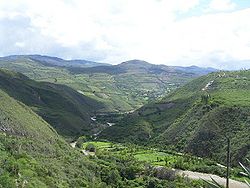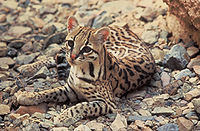
Bagua Province
Encyclopedia

Amazonas Region
Amazonas is a department of northern Peru bordered by Ecuador on the north and west, Cajamarca Department on the west, La Libertad Department on the south, and Loreto Department and San Martín Department on the east. Its capital is the city of Chachapoyas....
in Peru
Peru
Peru , officially the Republic of Peru , is a country in western South America. It is bordered on the north by Ecuador and Colombia, on the east by Brazil, on the southeast by Bolivia, on the south by Chile, and on the west by the Pacific Ocean....
. It is located in the north and central part of the department of Amazonas
Amazonas Region
Amazonas is a department of northern Peru bordered by Ecuador on the north and west, Cajamarca Department on the west, La Libertad Department on the south, and Loreto Department and San Martín Department on the east. Its capital is the city of Chachapoyas....
. Its territory is rugged in all its extension. It is also cut by deep gorges
Canyon
A canyon or gorge is a deep ravine between cliffs often carved from the landscape by a river. Rivers have a natural tendency to reach a baseline elevation, which is the same elevation as the body of water it will eventually drain into. This forms a canyon. Most canyons were formed by a process of...
that have been formed by the important river
River
A river is a natural watercourse, usually freshwater, flowing towards an ocean, a lake, a sea, or another river. In a few cases, a river simply flows into the ground or dries up completely before reaching another body of water. Small rivers may also be called by several other names, including...
s that cross this province, as well as their numerous tributaries
Tributary
A tributary or affluent is a stream or river that flows into a main stem river or a lake. A tributary does not flow directly into a sea or ocean...
.
Bagua's heights are very varied. They can mainly go up to 400 m. in the banks of Marañón
Marañón River
The Marañón River rises about 160 km to the northeast of Lima, Peru, flows through a deeply-eroded Andean valley in a northwesterly direction, along the eastern base of the Cordillera of the Andes, as far as 5 degrees 36' southern latitude; then it makes a great bend to the northeast, and...
and Santiago rivers up to 2500 m. in the mountain zone
Mountain range
A mountain range is a single, large mass consisting of a succession of mountains or narrowly spaced mountain ridges, with or without peaks, closely related in position, direction, formation, and age; a component part of a mountain system or of a mountain chain...
of the south
South
South is a noun, adjective, or adverb indicating direction or geography.South is one of the four cardinal directions or compass points. It is the opposite of north and is perpendicular to east and west.By convention, the bottom side of a map is south....
.

Marañón River
The Marañón River rises about 160 km to the northeast of Lima, Peru, flows through a deeply-eroded Andean valley in a northwesterly direction, along the eastern base of the Cordillera of the Andes, as far as 5 degrees 36' southern latitude; then it makes a great bend to the northeast, and...
, one of the principal rivers in the Peruvian Amazon. From south to north-east, it is crossed by the Chiriaco
Chiriaco River
The Chiriaco river is a river in Peru. The Chiriaco is a tributary of the Marañón and takes Tuntungos, Shushug and Wawas as principal tributaries....
or Imaza river
Chiriaco River
The Chiriaco river is a river in Peru. The Chiriaco is a tributary of the Marañón and takes Tuntungos, Shushug and Wawas as principal tributaries....
. From southeast to north, it is crossed by the Nieva river
Nieva River
The Nieva River is a tributary of the Marañón River in Peru. Its length, from the east in the mountain range of Campanquiz to the mouth is approximately 150 kilometers....
and from east to northwest by the Utcubamba river
Utcubamba River
The Utcubamba River is a river in the Amazonas Region of Peru, located at . The river's name is Quechua for "cotton fields".The Utcubamba River originates in the highlands of the central cordillera, then flows north through Amazonas before joining the Marañón River...
.
The city of Bagua is located on a natural platform raised from the right shore of the Utcubamba river
Utcubamba River
The Utcubamba River is a river in the Amazonas Region of Peru, located at . The river's name is Quechua for "cotton fields".The Utcubamba River originates in the highlands of the central cordillera, then flows north through Amazonas before joining the Marañón River...
. All the houses of the western part of the city have a view of the river waters.
There are a big quantity of animals that are typical of the zone: huangana
White-lipped Peccary
The White-lipped Peccary, Tayassu pecari, is a peccary species found in Central and South America, living in rainforest, dry forest and chaco scrub. It is monotypic within the genus Tayassu....
s, pumas, anteater
Giant Anteater
The Giant Anteater, Myrmecophaga tridactyla, is the largest species of anteater. It is the only species in the genus Myrmecophaga. It is found in Central and South America from Honduras to northern Argentina...
s, tigrillo
Ocelot
The ocelot , pronounced /ˈɒsəˌlɒt/, also known as the dwarf leopard or McKenney's wildcat is a wild cat distributed over South and Central America and Mexico, but has been reported as far north as Texas and in Trinidad, in the Caribbean...
s, cashpaicuros, armadillos. There are also numerous snake
Snake
Snakes are elongate, legless, carnivorous reptiles of the suborder Serpentes that can be distinguished from legless lizards by their lack of eyelids and external ears. Like all squamates, snakes are ectothermic, amniote vertebrates covered in overlapping scales...
s such as the macanche, colambo, uyurechonte, cascabel
Rattlesnake
Rattlesnakes are a group of venomous snakes of the genera Crotalus and Sistrurus of the subfamily Crotalinae . There are 32 known species of rattlesnake, with between 65-70 subspecies, all native to the Americas, ranging from southern Alberta and southern British Columbia in Canada to Central...
, shushupe
Lachesis (genus)
Lachesis is a genus of venomous pitvipers found in remote forested areas of Central and South America. The generic name refers to one of the Three Fates in Greek mythology who determined the length of the thread of life...
, etc. The natives hunted them for food. Thanks to the valuable number of species, a tourist current dedicated to the sport of hunting can be achieved, of course with rules adapted to assure the survival of these species. For collectors, the quantity and variety of butterflies
Butterfly
A butterfly is a mainly day-flying insect of the order Lepidoptera, which includes the butterflies and moths. Like other holometabolous insects, the butterfly's life cycle consists of four parts: egg, larva, pupa and adult. Most species are diurnal. Butterflies have large, often brightly coloured...
can be of big attraction in the wooded zone of the district principally.
Political division
Bagua is divided into six districtDistrict
Districts are a type of administrative division, in some countries managed by a local government. They vary greatly in size, spanning entire regions or counties, several municipalities, or subdivisions of municipalities.-Austria:...
s, which are:
| DISTRICT | MAYOR |
|---|---|
| Aramango Aramango District Aramango is a district of the province of Bagua. The first settlers were the families aguarunas , that were located, in what today it is the Principal Park, with the arrival of the colonists in the year 1955 approximately, native these were displaced, sheltering in the first moment in the Native... |
César Córdova Gonzáles |
| Bagua Bagua District Bagua District is one of six districts of the province Bagua in Peru. The district was created by law on April 26, 2008.-References:... |
Luis Sacarias Nuñez Teran |
| Copallín Copallín District Copallín is a district of the province of Bagua, Peru, located along the Amazon River.-History:The first historical account regarding the current population of the district of Copallín is tied to the history of Copallín Viejo, erected in the current district of Aramango.Don Juan Requejo Guerrero,... |
Enilo Cruz Cruz |
| El Parco El Parco District -References:... |
Absalón Cardozo Díaz |
| Imaza Imaza District -References:... |
Sergio Suwikái Tatse |
| La Peca | Alfonso Mendoza Lingán |

